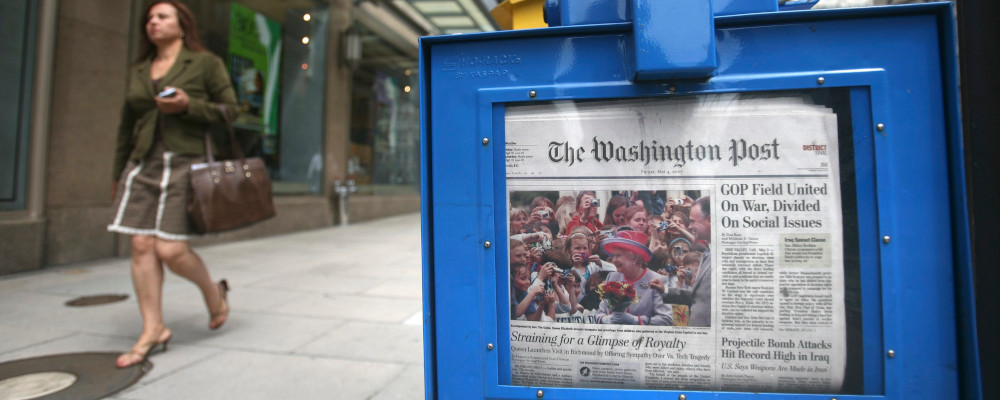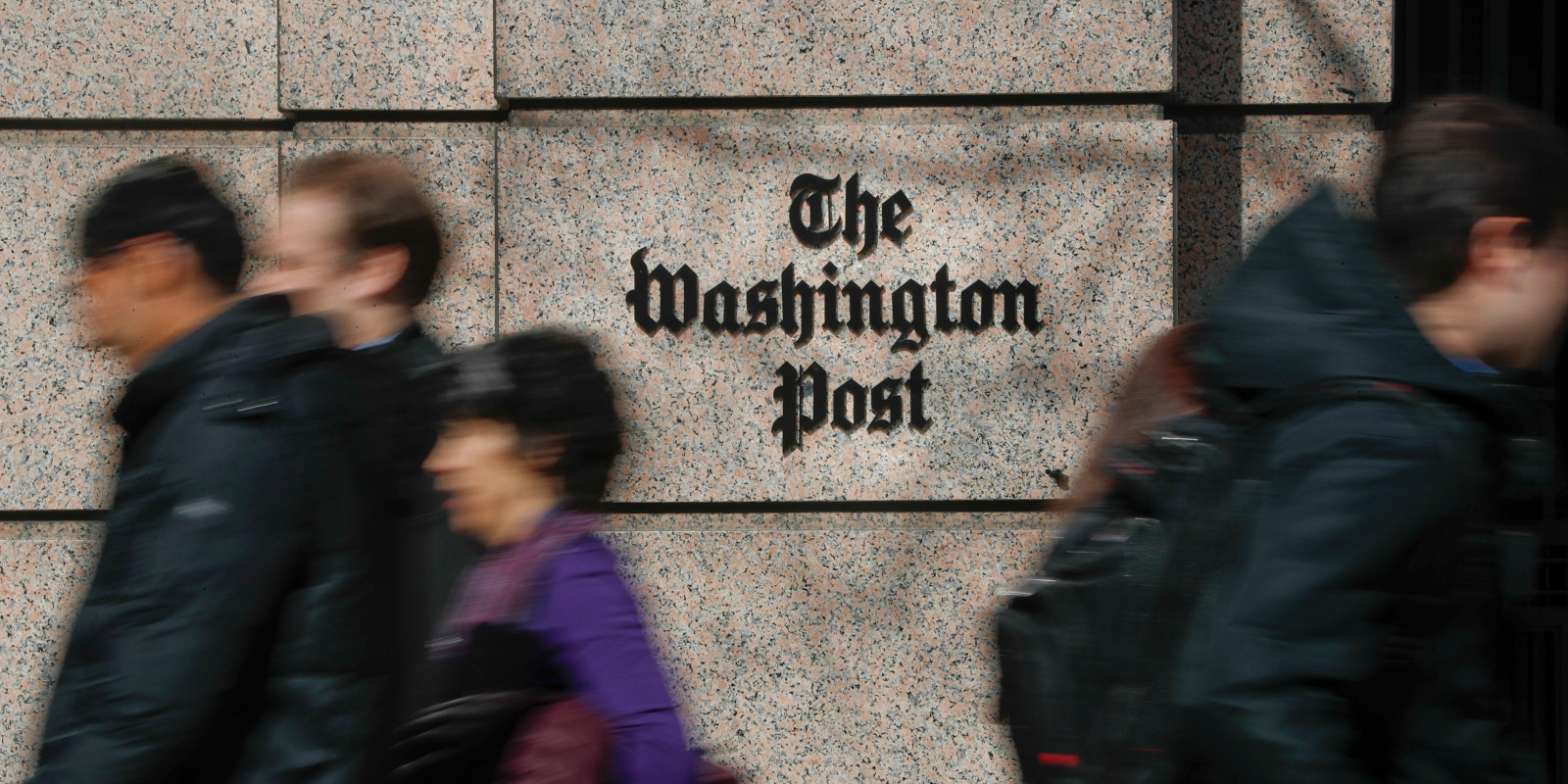The news media in Canada is in crisis. Policy responses to date are failing to solve for the information that citizens need to make informed decisions about important issues and debates. The Future of News series brings together leading practitioners, scholars, and thinkers to imagine new business models, policy responses, and journalistic content that can support a dynamic future for news in Canada.
In 2017, on its 140th birthday, The Washington Post inaugurated its first-ever slogan: Democracy Dies in Darkness. The newspaper, world-famous for taking down former U.S. president Richard Nixon, was now setting its sights on holding the administration of another president to account: Donald Trump. Beneath the branding exercise, however, was a push to revitalize the news outler. After Amazon founder Jeff Bezos purchased The Post in 2013 for $250 million, the newspaper had achieved something rare in the beleaguered journalism industry: profitability.
Bezos wasn’t the only billionaire sweeping up a distressed legacy outlet, in hopes of restoring its editorial product and finances. In the 2010s, business magnates bought newspapers across the U.S., ushering in a new generation of press barons: John Henry and The Boston Globe, Glen Taylor and the Minneapolis Star-Tribune and Patrick Soon-Shiong and the L.A. Times, to name a few. But their efforts have been mixed: from profit and Pultizers, to newsroom uproars and massive financial losses. Among these billionaires, however, Bezos emerged as the shining example of the modern mogul.
What’s old is new again
Through the 19th century, the business of newspapers, once under the purview of partisan political movements and parties, evolved alongside printing press technology. This enabled wider reach, as well as better distribution among audiences, catapulting the value of advertisements. By the start of the 20th century, William Randolph Hearst, Joseph Pulitzer, E.W. Scripps and other press barons made their riches off their news properties and bought up others around the country, turning their newspaper chains into empires.
By the 1970s, many newspapers, still highly profitable, were bought up by publicly-traded companies, becoming subject to the whims of the market, writes journalism professor at Northeastern University’s College of Arts, Media and Design Dan Kennedy in his 2016 report, The Bezos Effect.
But by the 2000s, advertising revenues, the lifeblood of the news industry, were being taken by new players on the internet. Craigslist ate away at the classified section. Google and Facebook cornered the digital advertising market. The results, for newspapers, have been devastating. From 2005 to 2021, around 2,200 American newspapers closed, according to The Washington Post. From 2008 to 2020, the number of newspaper journalists diminished by more than half.
Properties like The Boston Globe, which The New York Times bought for $1.1 billion in 1993, was sold for $70 million (in cash) in 2013 to Boston Red Sox owner John Henry, who made his fortunes trading commodities.
The first generation of press barons built their empires by becoming newspaper publishers, but “for this new generation of barons, it’s the opposite,” says Kennedy, in an interview with The Hub. “They made their fortunes in other ways, and they were hoping to apply their expertise to the wickedly difficult problem of saving the news business.”

Turning around The Post
Even storied newspapers like The Washington Post were feeling the pressures of the newspaper industry. In his report, Kennedy documents the financial state of the paper at the end of the famed Graham family’s stint as owners. In the first three quarters of 2011, revenues fell 10 percent, to $3.15 billion, while overall profits dropped 72 percent to $55 million, remaining in the black through cost-cutting. Between 2003 and 2008, The Post reduced its staff of 900 journalists by more than 200. By the time Bezos purchased the paper in 2013, there were around 560 journalists employed. Although the Graham family owned a controlling share of the publicly-traded company, Kennedy says they were still beholden to shareholder demands. On Wall Street, “being profitable isn’t good enough if you can be more profitable,” describes Kennedy.
Enter Bezos, then the world’s richest man, whose wealth was built on the disruptive force of Amazon, a digital retail company that slogged through years of losses in the pursuit of expansion, before turning massive profits. Kennedy says Bezos then applied the same “Get Big Fast” approach to The Post, which had largely been a metropolitan paper that, only by virtue of its proximity to the seat of the federal government, also covered national politics. Under Bezos and editor-in-chief Marty Baron, The Washington Post pivoted towards a national audience, invested in digital-first content, and optimized the website and mobile app, in the hopes of selling digital subscriptions through bundles.
“We have historically made a relatively large amount of money per reader on a relatively small number of readers. And we need instead to make a relatively small amount of money per reader on a much larger number of readers,” Bezos said in 2016.
Given billionaire Bezos’ deep pockets, Amazon’s network, and a long-term business plan, The Post was no longer under immediate pressure to turn a profit and was able to focus on improving its editorial product and its digital infrastructure. The paper hired 35 more software engineers to build a new, proprietary content management system (CMS) called “Arc”, along with introducing an array of tools to design infographics and data journalism.
The investments worked. Kennedy writes that in 2015, the Post attracted 66.9 million unique visitors – a 59 percent increase from the previous year, and about a million more unique users than the New York Times. In 2016, Bezos said the newspaper was actually turning a profit. By 2017, the number of journalists employed had climbed from 560 when Bezos took over, to 700. It reached more than 1,000 by 2021.
Billionaire Blunders
Despite these successes at The Post, the media mogul business model elsewhere has had, at best, mixed results.
Technology entrepreneur Aaron Kushner went all-in on print when he bought The Orange County Register in 2012. Financially, “[Kushner] couldn’t even play in the same ballpark as people like Henry and Bezos,” says Kennedy. “So he took his one shot at it, and when it didn’t work, he was out of money,” by 2015. After staff cuts, furloughs and closures the outlet resorted to asking journalists to deliver their own papers.
In 2020, billionaire investor Warren Buffett sold Berkshire Hathaway’s 31 newspapers. “He never had any interest in saving newspapers,” Kennedy admits. “He just saw them as another investment, and, once he decided he had gotten what he was going to get out of them, he moved on.
The Baltimore Sun’s owner, businessman David Smith, got off to a rocky start after he reportedly told the newsroom in a three hour meeting that, “he had read the paper only a few times in recent months and hadn’t read it at all in the previous 40 years,” He then “urged them to increase profits.”
Smith “seems to have some political agenda at work,” says Victor Pickard, professor of media policy and political economy at the University of Pennsylvania. “I think we should be more leery today in terms of why anyone buy a newspaper at this point. What is their ulterior motive?” The academic recently criticized billionaire ownership in The Conversation.
However, Pickard admits that Bezos appears not to have directly put his thumb on The Post’s editorial needle. Days after his purchase was announced, The Post wrote about Bezos’ tenure at Amazon, highlighting his “tirades” against colleagues and Amazon’s workplace conditions. Bezos even told his reporters to “feel free to cover Amazon any way you want, feel free to cover Jeff Bezos any way you want.”
Among this entitled crop of billionaire owners, Kennedy says Bezos was in a unique position, both in terms of the scale of his finances and with the potential reach of The Washington Post. “He acquired a property that he was able to reposition as a national source of news. The others didn’t have that opportunity,” Kennedy says. But in recent years, even The Post has struggled. The New York Times reported it was losing money in 2022, as digital subscriptions plateaued and even dipped after 2020.
In 2023, The New York Times reported the losses for The Post that year could hit $100 million, triggering voluntary buyouts for 240 staff, or roughly 10 percent of the company. The Washington Post did not respond to requests from The Hub for comment.
“I think that what we’re seeing now is just a cyclical re-adjustment to reality that The Post did not make a good transition to Trump leaving the White House,” Kennedy says. Beyond its bread-and-butter of politics and investigations, he says the paper hadn’t substantially expanded its reach.
Pickard believes the initial successes of The Post could be attributed more to a temporary “Trump Bump” that capitalized on outrage and intrigue surrounding the controversial president. “The Washington Post, more than most papers, rebranded itself as very critical of the Trump administration,” Pickard says. “ But of course, now there’s, if anything, probably Trump fatigue.”
Meanwhile, its main competition The New York Times acquired The Athletic, a popular online sports publication, hired conservative opinion writers that could speak to Americans who leaned right and even branched out its digital offerings to include recipes and even games. “You get it for Wordle as much as you do for anything,” Kennedy says.
Despite the setback, Kennedy notes that The Post’s editorial staff levels remain far above before Bezos first purchased the paper. “It may be that the years that Trump was in the White House will prove to be the high watermark for The Post. But if they could stop shrinking and grow modestly again, I think they’re still in good hands,” he says.
Pickard is less optimistic. “I really think by now, we should be facing the uncomfortable fact that there is no market-based future for the kinds of journalism that democracy requires,” he says. “We’re still seeing the crumbling of the advertising revenue model. And the data keeps showing that only a small percentage of readers are willing to pay for news.”
While he acknowledges there are pockets of billionaire success, like the Minneapolis Star-Tribune and The Boston Globe, he says the model is not easily replicable, especially in local communities. “[Billionaires] might save a newspaper here and there, but it’s not ever going to serve as a systemic fix.”

What about Canada’s billionaires?
Replicating the Bezos model is challenging enough in the U.S., and is even more complicated in Canada. “There are only so many billionaires in Canada. And, by definition, the group of those who are benevolent will be even smaller,” says Ed Greenspon, president and CEO of the Public Policy Forum. “You’re fishing in a pretty small pool here.”
In 2017, Greenspon, a former editor-in-chief at The Globe and Mail, authored the Shattered Mirror report, which assessed the state of journalism in Canada. At the time, he noted that three billionaire families already owned newspapers in Canada: The Thomsons owned The Globe and Mail, the Irvings owned the Brunswick News chain, and the Desmarais family had La Presse. As of 2024, the Thomsons are the last of a dying breed. The Irving family sold its papers to Postmedia, while the Desmarais family divested from LaPresse, as it converted into a non-profit.
“We don’t really know how [The Globe and Mail] does [financially]. But it has almost 50 years of support and identity and dedication to it as an asset,” Greenspon says about the paper’s long term sustainability. Given its track record, Greenspon believes the Thomson family would be willing to “give back”, by holding back from extracting profits from the paper, at the cost of its editorial product. “They may not attain their maximum return from that particular asset, and I think they’ve been content with that.” The Globe and Mail’s editor-in-chief David Walsmley and President and CEO Andrew Saunders did not respond to The Hub’s requests for comment. There is no publicly available information around whether the paper turns a profit or not.
Another Canadian issue for billionaire buyers, Greenspon notes, is scale. “If you want to primarily appeal to a Canadian audience, that’s going to be a much smaller audience,” he says. Bezos’ “Get Big Fast” motto worked for The Washington Post because the outlet could, through its coverage of federal politics, expand its digital presence across a country of 331 million people, and even draw international eyes. Meanwhile, a national paper in Canada can only draw an audience roughly a tenth that size.
Plus, the economic incentives of the internet “has a higher propensity to reward scale,” Greenspon says. Meanwhile, profitability achieved by widespread digital reach could end up diluting news geared towards Canadians. Publications like Vice Media, he notes, “grew out of their Canadian roots very quickly, because there were larger markets.”
Greenspon’s report outlined various solutions, including tax incentives, stronger regulation of intellectual property laws, opening up charity laws to help the creation of journalism foundations, and mandates for both The Canadian Press and the CBC.
But “I’m open to any model,” he says. “Not-for-profit models, publicly supported models, private sector models— they all might have their place.”
“Who knows?” Greenspons says. “If you could be a great innovator, you might be able to become a billionaire.”
Editors Note: The Hub’s Editor-at-Large Sean Speer is a Senior Fellow at the Public Policy Forum, which Edward Greenspon leads. Therefore, he did not take part in the editorial decisions involved in this article.
The Future of News series is supported by Meta and Hub contributors like you.
Recommended for You

‘A fiscal headache for Mark Carney’: The Roundtable on how Trump’s One Big Beautiful Bill could affect Canada

‘There are consequences to this legislation’: Michael Geist on why the Canada-U.S. digital services tax dustup was a long time coming

Rudyard Griffiths and Sean Speer: The future of news in Canada: A call for rethinking public subsidies

‘Our role is to ask uncomfortable questions’: The Full Press on why transgender issues are the third rail of Canadian journalism



